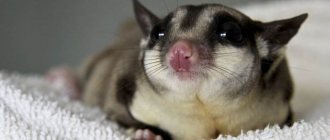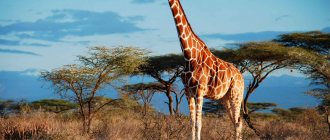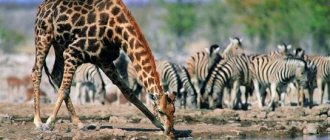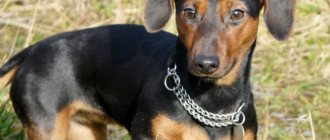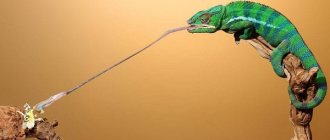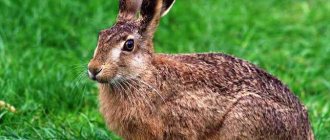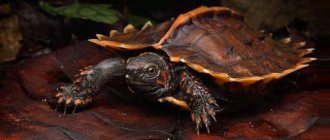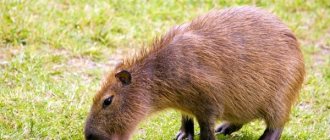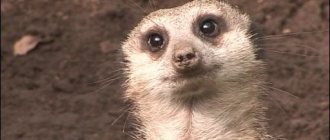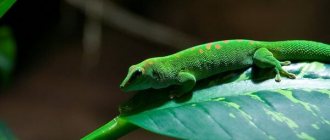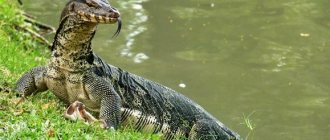- Wild animals
- >>
- Mammals
It is difficult to imagine that such an unusual, slightly funny, small marsupial animal like the opossum is one of the oldest animals that has survived to this day, practically unchanged in appearance. Many fell in love with them after the release of the animated film “Ice Age,” where two funny possums Eddie and Crash got into various exciting adventures, which were followed by millions of people around the planet. Let's try to understand in more detail the history and life activity of this furry animal.
Origin of the species and description
Photo: Possum
The possum family is a class of marsupial mammals that inhabit mainly the American continent (both South and North America). These are one of the oldest inhabitants of the Earth, having survived to this day since the Cretaceous period. It is noteworthy that since those distant times the animals have not changed at all in their appearance, so to speak, they have been preserved in their original form.
As for America, scientists have found that opossums originally inhabited only the South American continent. Later, when the so-called bridge between the two Americas arose, many species of all kinds of animals from North America began to migrate to South America, which led to a huge death of marsupials in South America. Of course, not all types of possums have survived, but the good news is that at least some have survived to our times and managed to perfectly adapt to new living conditions.
Video: Possum
In addition to the fact that these small animals managed to survive and adapt to changes, they themselves spread throughout North America almost to Canada. When studying the origin of these animals, you should definitely pay attention to excavation data, which tells us that once, in ancient times, possums inhabited Europe.
If we delve not into the most ancient history, but into the one that is accessible to man, then one of the first mentions of the opossum was made in the book of the Spanish geographer, priest and historian Pedro Cies de Leon back in 1553, this work is called “Chronicle of Peru”. In it, the Spaniard described a small animal still unknown to him, which resembled a fox, had a long tail, small paws and brownish fur.
The closest relatives of possums from America are the rat possums. As already noted, there are many varieties of possums, they are different in appearance and inhabit a variety of territories.
Let's describe some of them:
- The common opossum is quite large, its weight can reach up to 6 kg. The animal loves forest areas located along the banks of various bodies of water, feasts on cereals, lizards, and eats various insects and mushrooms;
- The Virginia opossum is also large in size (up to 6 kg), loves forests with high humidity, but also lives on the prairies. Eats small rodents, birds, bird eggs, young rabbits;
- The water possum naturally lives near the water, eats fish, crayfish, and shrimp, catching its dinner right on the water. Sometimes enjoy fruit. It is not as prolific as other species of its family;
- The mouse opossum is very small. Its length is about 15 cm. It loves mountain forests (up to 2.5 km in height). Eats insects, bird eggs and all kinds of fruits;
- The gray naked-tailed opossum is very miniature, its weight is just over one hundred grams, and its length is from 12 to 16 cm. It prefers flat terrain, densely covered with small grass, and likes to be adjacent to human habitation;
- The Patagonian opossum is very tiny, weighing only about 50 grams. Its main diet is insects.
Of course, there are other varieties of possums besides those listed.
They provide free pest control
Photo source: iStock
Because possums' diet allows them to feast on snails, slugs and bugs, they can be a welcome addition to the garden. They also help clean up sources of pests by eating rotting fruits and vegetables. Opossums also repel rats and cockroaches by competing with them for food. In fact, opossums will often kill cockroaches and rats if they find them on their property. ()
Appearance and features
Photo: Possum animal
We found out that there are different types of opossums in nature, so we will consider the characteristic external signs and features of this animal using the example of an ordinary opossum. The dimensions of this animal are small, it reaches a length of about 60 cm, females are 10 centimeters smaller. In general, the opossum is similar in size to an ordinary adult cat. His muzzle is pointed and elongated.
The tail of the animal is powerful, bare, not covered with hair, and at the base it is much thicker. With its help, the opossum hangs on branches when sleeping or moving in the crown of trees. The opossum's coat is not long, but thickly padded and dense.
The color of the animals varies depending on their species and habitat, so possums can be:
- Dark gray;
- Brownish-gray;
- Brown;
- Light gray;
- Black;
- Beige.
If we talk about the common opossum, then its fur is gray with whitish streaks, and its head is lighter, on which beady black eyes and rounded ears stand out. The animal has five-fingered paws, each toe has a sharp claw. The animal's jaws indicate its primitiveness. The opossum has 50 teeth, 4 of them are fangs, their structure and location are similar to the structure of the teeth of ancient mammals.
A characteristic feature of the animal is the presence of a pouch in which it carries its cubs, because they are born prematurely, and in it they grow up and become stronger. The bursa is a fold of skin that opens towards the tail. It is interesting that some varieties of opossums lack a pouch, i.e. are marsupials, and the cubs hang on the mother's breast until they gain independence.
Their paws have thumbs
Just like humans and other primates, the opossum has the equivalent of opposable thumbs. Each of the opossum's big toes on its hind feet, called the big toe, is opposable; they are located separately from the other toes, much like the human palm and thumb. The opossum's thumb allows it to grasp and climb better than most other mammals. Unlike the opossum's other toes, the big toe is the only one that does not have a claw. ()
Where does the opossum live?
Photo: Great Possum
Nowadays, opossums have retained their permanent residence only in the New World, although previously they were widespread throughout Europe, as evidenced by paleontological excavations. Opossums settled throughout the territories of both Americas (North and South). Recently, zoological scientists have noticed that their permanent habitat is moving much further north, reaching the southeastern part of Canada and the Lesser Antilles.
Opossums prefer forests, steppes, and semi-desert areas. They live both on plains and in mountainous areas, not going higher than 4 km. Because There are many varieties of possums, and they give preference to different habitats. Some species require close proximity to water; they lead a semi-aquatic lifestyle, making dens in tree hollows. Still, most representatives of the opossum family live in trees or on the ground.
An interesting observation is that some species settle closer to human dwellings, although for the most part possums prefer to avoid humans, bypassing them.
They are always well-groomed
Photo source:
Although opossums may appear unkempt, they are actually very meticulous in grooming themselves. When opossums are not searching for food or sleeping, they groom themselves. Like cats, opossums follow the same pattern of licking their paws and wiping their faces. They clean their entire body from head to tail, using their claws to comb the fur and remove insects to chew. Female opossums are particularly particular about keeping their pouch clean, especially when caring for their young. (, )
What does an opossum eat?
Photo: Funny possum
We can say that the opossum is an omnivore. It feeds on both plant and animal foods. In general, his taste preferences largely depend on the type and place of his residence. It has been noticed that opossums eat a lot, it seems that they cannot get enough, but this is not so. Animals are very prudent and eat in reserve, storing up fat in case hungry, difficult times come. Cannibalism is a common occurrence among these wild animals.
Typically the opossum menu consists of:
- All kinds of berries;
- Fruit;
- Gribov;
- Various insects;
- Small lizards;
- Small rodents;
- Fish, crustaceans, shrimp (from the water possum);
- Small birds;
- Bird eggs;
- Herbs;
- Foliage;
- Corn cobs;
- A variety of grains.
If you have such an unusual pet as an opossum, you can feed it a variety of vegetables, fruits, chicken and eggs. The opossum can also be given regular cat food, but not always and not too often. And his appetite is always excellent.
They have natural defenses
Joe McDonald/Getty Images
When threatened, opossums run, growl, burp, urinate and defecate. And when all these methods do not work, they are pretended to be dead. This is an involuntary reaction (such as fainting) and not a conscious act. They roll over, become stiff, close their eyes (or look with their eyes open) and expose their 50 small teeth. Saliva forms around the opossum's mouth, and a foul-smelling fluid is secreted from the anal glands.
The catatonic state is more common in young opossums and can last up to six hours. Adult animals are more likely to confront enemies or run away at speeds of about 6.5 kilometers per hour. ()
Features of character and lifestyle
Photo: Possum
By nature, opossums are loners and only get a mate during the mating season, preferring to lead a solitary, isolated way of life. These animals lead a crepuscular lifestyle, becoming more active when it gets dark. During the daytime, animals lie down in their burrows or in the crown of trees, hanging on a branch with the help of their strong tail, reminiscent of tentacles. Sweet and sound sleep is a favorite activity for opossums, which they can continuously do for about 19 hours a day.
In general, the animals are very timid and cautious by nature, they avoid meeting people, and catching a possum is not an easy task. On top of everything else, they are real quiet people, making almost no sounds. The animal screams extremely rarely, only when it experiences severe pain. In other cases, possums have no reason for heated discussions and loud conversations. The animals have a fairly calm disposition; they have not been observed to exhibit frequent aggressive behavior.
Opossums are talented tree climbers, ready to hang on tree branches all day long; they often sleep upside down, clinging to a branch with their tail. Also, with the help of the same tail and tenacious clawed paws, they deftly move in the green crown. Of course, there are species that live exclusively on the ground, but there are many more opossums that lead an arboreal lifestyle. Naturally, the water opossum's talent is its ability to swim, which it uses perfectly when getting food from the water.
One of the features of the life activity of opossums is their nomadic (wandering) lifestyle. They constantly move from place to place, without having their own separate territory, like many other animals. Animals living in the northern regions hibernate during severe cold weather. During it, on the warmest and sunny days, the opossum wakes up to eat, staying awake for a short time.
Among those who have acquired such an exotic pet as an opossum, there is an opinion that these animals do not have great intelligence, but they are very playful and flexible, you definitely won’t get bored with them!
They have an impressive tail
Jay Ondrejka/Shutterstock
Opossums have prehensile tails, which they use as a hand or fifth appendage. Their long hairless tails reach almost the same length as the opossum's body. Their tails allow them to grab and wrap around things such as tree branches. The tail also helps maintain balance. Opossums can hang by their tails, but only for a short time. ()
Social structure and reproduction
Photo: Baby opossums
Single opossums mate only for a short mating period. In different species it occurs at different times. For example, the North American opossum gives birth to offspring about three times a year, and those species that prefer tropical areas breed all year round. Animals that do not live in trees make something similar to bird nests, and land animals breed in abandoned burrows, secluded holes and between large tree roots.
It should be noted that opossums are quite prolific. There can be up to 25 babies in a litter, but this is rare. Usually between 8 and 15 cubs are born. Although it happens that a large number of cubs are born at once, only the fastest and strongest survive, because the mother has only 12 or 13 nipples. The duration of a female's pregnancy is not long at all and is about 25 days; in small species it is generally about 15. The babies are very tiny and premature, similar to embryos, their weight is only 2 - 5 grams.
In marsupial opossums, babies mature in the pouch, where the nipples are located to supply the babies with milk. In non-marsupial animals, the babies hang directly on the mother's breast, clinging to the nipples. After about a couple of months, babies become like adult animals, becoming covered with hair, gaining sight and gaining weight. It is interesting that mothers feed their babies breast milk for a long time; this period lasts for three whole months.
Life is not easy for a mother opossum, this can be said both literally and figuratively, because the grown-up children with the whole large family ride on her, clinging to the fur on her back. Considering that the mother has many children, it is difficult to imagine what a heavy burden she has to carry every day. After three months of breastfeeding, babies begin to eat like adults. And both females and males become sexually mature by 6–8 months of age. Opossums live in their natural environment for about five years; in captivity, some specimens lived up to nine years.
INTERESTING FACTS. DID YOU KNOW THAT...
- The female Virginia opossum gives birth quite easily. Within five minutes, she can give birth to approximately 20-30 cubs.
- Newborn Virginia opossum cubs are very small. They weigh only 3 grains (1/5 of a gram). A teaspoon can hold 20 babies.
- The air inside a possum's closed pouch can contain 5-6% more carbon dioxide than outside.
- Some Virginia opossums live very far north. During harsh winters, their tails and ears freeze.
Natural enemies of opossums
Photo: Animal possum
In the wild, opossums have many enemies, because they are quite small and shy animals, so many larger predators are not averse to feasting on them. Among the possum's ill-wishers are lynxes, foxes, owls and other large birds of prey, coyotes. All kinds of snakes also pose a danger to young animals. In addition to predators, a large number of animals are killed by a disease such as rabies, the carrier of which is often the Virginia opossum.
It is worth talking separately about the unique method of protection from predatory attacks that opossums use when staging entire theatrical performances. When the threat is imminent, the opossum plays dead so skillfully that the predator has no idea that he is only pretending. The opossum falls, its eyes become glassy, foam is visible at the mouth, and special anal glands emit a corpse-like odor. This whole picture scares away predators, who, after sniffing the “carrion,” feel disgust and move away. When the enemy has left, the animal comes to life and runs away, although for a couple of minutes it was long dead. Such a deceptive trick for opossums often works in their favor, saving many animals from death.
Nutrition
The characteristics of opossums' teeth suggest that they are carnivores, but in reality they can eat any food .
Their main food is garbage and carrion. They also do not disdain insects, frogs, birds, fruits, earthworms, and sometimes their food can be the remains of other animals that died on the highway. Despite their harmless lifestyle, opossums have many natural enemies. They can easily become a victim:
- owls;
- eagles;
- foxes;
- dogs;
- cats.
They are of interest to people as a source of meat. There are many cases where these animals died in large numbers on the roads during hunting.
The opossum is one of the links in the ecosystem that forms the food chain of our planet. They feed on insects, fruits, small animals and other foods, but at the same time they can also be eaten by larger animals - coyotes, foxes, snakes and birds of prey.
